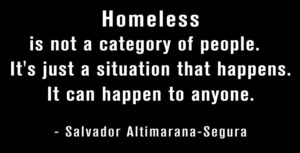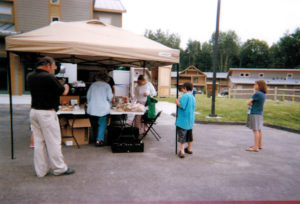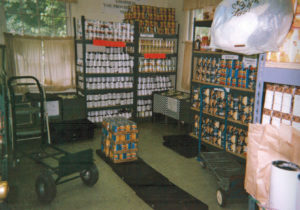My Search – The Food Pantry Needs a Refrigerator – “The Ketchup Sandwich Chronicles”
The pantry had a refrigerator and I needed a place to put it. But, to begin at the beginning, the food pantry had hungry people wanting and needing the hundreds of dozens of eggs we got from the food bank and Aldi’s.
Pantry volunteers needed a place to store the eggs before we distributed them. Where, oh where, could I put the refrigerator?
Early on pantry day, when I packed eggs in my car, nothing much else fit. Reusable shopping bags filled with eggs were in the rear hatch, on the seats, and on the floor. I felt like I was driving an egg mobile instead of a Prius. The only negative was refrigeration.
Each new food group added to the pantry shelves changed the dynamic, the pace of shopping in the room. Eggs were a huge addition. They were cheap. They didn’t take up much space but packed a nutritional punch. They were easy to cook. They were in big demand every time they were available in the pantry.
At the Food Bank of Northeastern New York in Latham I bought thirteen cases of loose eggs at a time whenever I could get them. When food bank stock was depleted, I bought over a hundred dozen eggs at a time at Aldi, a food store located at 767 East Chester Street in Kingston, across the road from Prestige Toyota. Aldi was the only local store willing to sell eggs to the pantry.
I tried to buy eggs at local farms and at Adams Fairacre, ShopRite, and Hannaford’s in Kingston. Nobody would sell eggs to the pantry because over a hundred dozen eggs were just too many and the pantry need wasn’t steady enough.
Aldi didn’t mind though. The store manager kept hundreds of dozens of eggs behind the glass door of a refrigerator case on the back wall of the store. All I had to do was open the door, wheel out the egg trolley, and load all the eggs I needed in large, reusable shopping bags which I brought with me. It took four shopping carts to get the loaded eggs to the checkout clerk.
I spent several months quietly searching for the refrigerator space I needed. I had a refrigerator and I just needed a place to put it. Then I got serious. I began with the church.
“Pastor, the pantry needs a refrigerator for eggs.”
“The pantry room is too small and the building committee won’t allow it.”
Next, I called around Woodstock from a list I’d made of people who might be willing to help me out. After the pastor, the Town Supervisor was top of the list. I was on his election committee when he successfully ran for office.
“Hi. I’m looking for refrigerator space for the pantry. Can I put one in the Community Center kitchen? I’ll donate it to the town. I just want to use it one day each week for eggs.”
“No.”
“Thanks.” Well, I thought, it’s a good thing I made a list!
I knew Woodstock Democratic Committee members. One was even on the Woodstock Town Board.
“I’m looking for refrigerator space for the pantry. I’ve got the refrigerator, I just want to use it one day a week for eggs. Do you know someplace in town where we can put one?”
“I’ll ask around and see what I can find.”
“How about Town Hall? There’s a large empty room there.”
“That won’t work. We’re going to renovate that building.”
My list is getting me nowhere fast, I thought.
At the end of the church parking lot stood a long, dirt floored, unpainted, rattlety trap building, a storage space for the popular Woodstock Village Green Bed and Breakfast. If I could get a corner in that old barn, I could put a refrigerator on a pallet. Dare I hope? I didn’t know the owners personally, but there didn’t seem to be any other options. So, I picked up the phone and called.
“I’m wondering if the pantry can rent a little corner of your barn for a refrigerator. I’m desperate for a place to store eggs. I’ve asked everyone and you are my absolute last hope.”
I might be able to pull this one off, I thought. When the pantry inspectors come, I just won’t mention the barn. I had to rely on food bank inspectors looking the other way and not asking about the food bank eggs.
One of the owners called back. “We can do this and there won’t be any charge.”
“Thanks. You’re going to heaven for this.”
“The refrigerator in the barn worked fine. Volunteers distributed eggs to shoppers on pantry day. Over time, local residents donated refrigerators and freezers.
Shopper census rose until we outgrew our small storage closet in the hallway.
“I need space Pastor. If you can’t spare a room for the pantry, I’ll just have to ask volunteers to bring the next shipment to my home where I’ll put it in my healing space. This is our biggest shipment yet, 3,000 pounds. The food is coming in.”
Each monthly shipment from the food bank up to this point had totaled less than 2,000 pounds. Pastor appealed to his consistory and the building committee. Word on the street was that many meetings followed and the pantry finally got, somehow, permission, maybe, to use the room at the end of the hall.
Food delivery day arrived and volunteers put food in the room. As they brought boxes into the room, I looked around. Nobody was there at the moment. The universe is on my side, I thought.
I hurried upstairs to the church office where I found the secretary. “We’re so happy to be able to store food in the room. Do you think it’ll be okay to bring a refrigerator in? This would mean we can keep eggs in the storeroom.”
Slowly, she smiled. “Sure, bring it in.”
Within minutes after I spoke with her, two men carried a refrigerator to the store room. “Put it against this wall,” I said, pointing to the one place where it would be least obvious.
At the end of the morning, building committee members inspecting the new storeroom saw a room full of food and a refrigerator filled with eggs. They were not happy.
I thought the pastor’s secretary was the number two person in the church so I went with her okay. The expressions on their faces taught me that the only people with any authority in that church were the building committee members.
From that morning on, pantry volunteers filled the stockroom to capacity with the food we got from the food bank. The refrigerator hummed along as we stacked eggs on every shelf in it weekly.
I don’t think I got permission to use the room permanently. It was a squatter’s rights kind of thing. Once I got the food in there, they couldn’t get me out. Before it was all over, the pantry received shipments every month exceeding 12,000 pounds.
The storeroom was a wonderful addition to the pantry. We routinely ordered food for advance needs during lean months and the refrigerator stored eggs.
The storeroom made all the difference.
Same with the barn. The dirt (mud when it rained) floor was permanently covered with flattened cardboard boxes and the refrigerators and freezers were stacked on pallets.
Was I wrong to have been so pushy?
Well, I don’t think so. I did make one mistake, though. I should have moved all the refrigerators and freezers into the storeroom that morning.
There were enough outlets.
Thank you. Thank you. Thank you for reading this article. Please share it with your favorite social media network.
Thurman Greco
Woodstock, New York
P.S. Please stay tuned for future chapters from my upcoming book “The Ketchup Sandwich Chronicles”.
I Don’t Hang Out in Churches Anymore – Coming Soon!
 IT’S COMING SOON!
IT’S COMING SOON!
After countless reams of computer paper, dozens and dozens of writing classes, three computers and two copiers, the book about hunger is at the publisher’s!
And, I actually heard the word “done” today! I’m ecstatic beyond words!
Somebody else could have done it with only one computer disaster and one copier blow up. But, I never claimed to be a writer.
This endeavor took years. And, it was worth it. I felt this story needed to be told when I started writing it in 2013 and I’m sticking to my opinion. Hunger in America was then and is now a national event which needs to be shared.
A real Woodstock story, “I Don’t Hang Out in Churches Anymore” tells about the people in the pantry, channels my grandmother, and reveals a few miracles.
I’m proud to say that “I Don’t Hang Out in Churches Anymore” will, within days, be available in paperback and eBook editions on Amazon.
I am already scheduling book signings for this book. If you are in the area, I look forward to seeing you at one near you!
You can purchase this book by going to my website at http://www.thurmangreco.com.
Order your copy, and please share this unbelievably exciting news!
Thurman
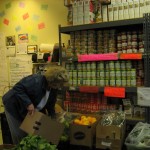
Please share this blog article with your preferred social media network!
Why I work in a pantry…even after all these years.
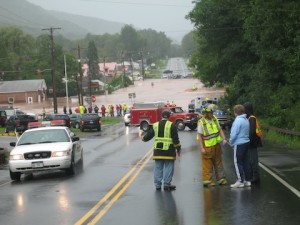
“This is perfect weather for a flood” she said casually. “It’s good to see the county out cleaning the ditches by the roads. We need to be ready.”
As I write this post, my mind travels back in time to the 1st pantry day after both Hurricane Irene and Super Storm Sandy. I managed a pantry in Woodstock, NY then. What pantry days they were! People came in looking for anything and everything they could find. They were upset, scared, coping with loss. Many had lost everything – car, house, job. They didn’t know where to turn.
Sadly, neither did I. As they filed in the pantry room, they asked questions that I couldn’t answer. So…I referred them to Family of Woodstock down the street. I simply didn’t know what else to do.
So, now I fast forward to the present where I manage a pantry in Boiceville, NY. Residents here are still recovering from Irene and Sandy. At this pantry, I see some of the same people I saw in Woodstock. Recovery is slow.
Reservoir Food Pantry volunteers work to assure that quality food is available for the many individuals and families in Ulster County. They struggle with food insecurity, homelessness, and underemployment. About 40% of our clients are transportation challenged and we deliver food to them.
Hunger comes in several categories in our area:
elderly poor
employed poor
ill poor
infant poor
generational poor
persistent poor
resource poor
situational poor
struggling poor
Regularly, without even a second thought, volunteers at our pantry located in the Ashokan Reservoir area of Upstate New York, work hand-in-glove with UlsterCorp volunteers, Rondout Valley Growers’ Association. Together, they make an an ongoing effort to provide enough food for those struggling daily with hunger.
Now, in 2015, area pantries are working to be a cohesive group with food storage and safety procedures known by everyone. We know, even if no one else does, how much the area hungry and homeless need the food. Hunger alleviation cannot be effectively carried out in a vacuum.
Our success depends on long term commitment and collaboration. We need to be able to escalate services when needed. Volunteers in our group are here for the time and effort necessary to fight hunger and homelessness in our area.
www.ulstercorps.org
www.familyofwoodstockinc.org
www.goodmorningwoodstock.com
Thank you for reading this blog.
Please refer this article to your preferred social media network.
I hope you found this helpful. Please leave your comments below and check out our other posts.
Don’t forget to join the email list.
Peace and food for all.
Thurman Greco
8 Ways the Hungry Get Food.
Betty and her daughter are Woodstock born. They’ve shopped there regularly since the Good Neighbor Food Pantry opened and began feeding the hungry.
For years, they shopped at the pantry, CVS, Rite Aid, and Woodstock Meats between periodic trips to Walmart in Kingston. Then, several years ago, Betty’s husband died and trips to Walmart ceased to be part of the routine. It became a luxury for them when a relative invited them to ride along to Kingston to shop.
Finally, he died too, and now Betty and her daughter have no transportation to Kingston. They’re eating out of the pantry and CVS.
The combination of limited income, no access to affordable grocery stores, and no automobile makes life difficult for the 2 women. Although she probably qualifies, Betty has never gotten SNAP.
There are many people in a situation similar to Betty and her daughter. People in Betty’s situation learn to cope with lack of access to food and the complications created by a limited budget and no automobile. They
get SNAP if they can.
dumpster dive.
shoplift.
ask friends and relatives for food.
borrow $$$ for food from friends and relatives.
visit a friend or relative at mealtime.
go to the soup kitchen.
shop at a pantry.
Betty is a single senior living with an adult daughter. Life is a bit more complicated with young children in the household when there’s not enough food and no $$$. Households develop coping mechanisms to deal with the situation.
One such technique consists of simply serving less food.
Another consists of just skipping meals.
A third is to feed children what is available and adults go without.
But, whether the household has adult children, younger children, or no children at all, hunger is a reality for people in this situation. They are classified as either being at risk of hunger, or experiencing hunger depending on the severity of the situation.
Whatever the classification, one thing is certain:
People in this situation are intimately connected to hunger on a daily basis.
They are also a good example of the reality that in this country we have 2 food systems:
one for the poor and
one for everyone else.
Thank you for reading this book/blog.
Please send a comment.
Please refer this article to your preferred social media network.
Don’t forget to join the email list.
Peace and food for all.
Thurman Greco
An Open Letter to Tomo Jacobson
Thanks so much for writing to Chuck Klosterman of the New York Times about dumpster diving. I appreciate your stand that dumpster diving is moral. I also like your question about whether it is ethically wrong to dumpster dive. I never thought much about the ethics of dumpster diving before.
As a food pantry coordinator, I interact with people every week who dumpster dive to feed themselves as well as their children, parents, and housemates. We can’t explore the ethics of dumpster diving without exploring the ethics of allowing people in our country to go hungry because they can’t make enough $$$ at their jobs to buy food.
People who come to the Reservoir Food Pantry take a 3-day supply of food home to wherever and whatever that is each week. The other 4 days, they’re on their own.
That means they can buy the food if they have a SNAP card and if they can get to a store selling food. If they don’t have either the $$$ or a SNAP card, then they must get creative. That involves:
Panhandling
Borrowing $$$ from friends, relatives, neighbors
Showing up at someone’s house (friend, relative, neighbor) at mealtime
Sending the children to someone’s house (friend, relative, neighbor) at mealtime
Stealing and (of course),
Dumpster Diving.
In Woodstock, NY, where I live, a beloved neighbor named Cassia Berman routinely went dumpster diving for greens (kale, chard, collards). Cassia was on the library board and taught Qigung at the community center. She never made a fortune, certainly not enough to buy organic produce at the Sunflower Natural Foods Market.
Cassia felt good nutrition was her best defense against illness. I was always grateful for Cassia’s attitude. She brought class to the whole hunger scene.
Thanks for reading this blog/book.
Please send a comment.
Please refer this article to your preferred social media network.
Don’t forget to join the email list.
Peace and food for all.
Thurman Greco
Grandpa Woodstock
I’LL NEVER KNOW WHY THEY THREW HIM IN THE SLAM LAST WEEK. I MEAN…WHY NOW?
Father Woodstock, Grandpa Woodstock, or whatever you called him, showed up here almost 20 years ago. The story goes that he was homeless. At least, that’s what he told me in the pantry one day. “I’m the luckiest man in the world Thurman. I lived a homeless life all these years until I found the lovely Lady Estar. And, here I am now, married to a beautiful woman with 3 houses.”
Father Woodstock, Lady Estar, and their beloved dog Hector, visited the pantry every Wednesday afternoon right according to schedule. Hector waited outside the door in the colorful cart Father Woodstock had made for Lady Estar. Hector had a special little seat in the back of the cart. As far as I know, he never tried to jump out.
The only time they missed a pantry afternoon was when they took the bus somewhere and went on a vacation to get out of the heat in Woodstock. Maybe THAT has something to do with why he was arrested. He and Lady Estar didn’t go anywhere this August. Our summer this year was just too cool and too wonderful.
BUT, THAT’S GETTING AHEAD OF THE STORY.
Father Woodstock came to town and became the most colorful of the colorful. Everyone loves him…especially every woman he comes in contact with. I, personally, loved him more than the others when he came into the pantry carrying his walking stick with the horn attached.
“YOU LOOK LOVELY TODAY!” he always said with feeling as he tooted the horn for emphasis. “Toot. Toot.” My heart melted. Because, in reality, working in the pantry was tough with watchers counting the minutes, checking the hallway lines, complaining about the cardboard, and me feeding the unworthy hungry. For the few minutes that Father Woodstock came in the pantry to shop, none of it mattered.
LONGTIME RESIDENTS RECALL THAT FATHER WOODSTOCK PACKED UP HIS WORLDLY POSSESSIONS AND TOOK OFF FOR BIXBY, ARIZONA EACH WINTER ON THE BUS. Boy, that must have been a trip! I can just see Father Woodstock now, entertaining everyone with stories, peace sign salutes, and telling all the women how beautiful they were. I think I would’ve loved the trip. There never would have been a dull moment, that’s for sure. Toot. Toot.
ABOUT FIVE YEARS AGO, FATHER WOODSTOCK AND LADY ESTAR FELL IN LOVE. What a pair! They’re perfect for each other.
As they wwere out in public, he and Lady Estar were always beautifully dressed. They both wore silk…flowing silk skirts and beautiful silk kimonos. They had a nice selection of lovely silk jackets. Their wardrobes consisted mostly of floral prints in their favorite color: red.
BOTH FATHER WOODSTOCK AND LADY ESTAR WORE THEIR DRESSES AND SKIRTS LONG. Their toenails were always painted. They wore Teva sandals. They both had long flowing silky silver hair and beards.
Father Woodstock liked to come to the small pantry weekly and choose foods he and Lady Estar could serve to the homeless people they entertained. As he chose apples, oranges, carrots, he commented to other women shoppers how beautiful they were. “Toot. Toot.”
THE MAN MAY NOT HAVE MEANT A WORD OF IT…HE PROBABLY DIDN’T MEAN A WORD OF IT. Now that I think about it, Father Woodstock was probably the best actor in town. But, nobody cared. For the moment, life was beautiful.
So, here we have a scene…a pattern…a reputation. Father Woodstock conducted himself in a certain fashion all these years in Woodstock. Everyone knew him, residents and tourists alike. He trained us all to smile when he came around. He trained us to gather around and ooh and aah when he posed for photographs with a peace smile and sign. “Toot. Toot.”
IN HIS OWN WAY, FATHER WOODSTOCK WAS AN AMBASSADOR FOR THE TOWN OF WOODSTOCK. People came from far corners of the globe as well as just one or two towns down to catch a glimpse of him, his colorful cart, and his peace sign. In his own way, he brought much money to Woodstock because when the people came to see him, they also bought a cup of coffee, a meal, a “find” at the flea market, a pair of shoes at Pegasus, or a necklace at Gwen’s Gems.
AND, NOW, HE’S IN JAIL IN LIEU OF $50,000 CASH OR $100,000 BOND BAIL.
So, if he’s been possessing and selling drugs, paraphernalia, and pharmaceutical equipment for the past twenty years, why did they wait until the full moon in August, 2014, to throw him in the slam?
Oh well, that’s Woodstock for you.
Thank you for reading this hunger/food pantry blog.
Please refer this article to your preferred social media network.
Please leave a comment.
Don’t forget to join my mailing list.
Peace and food for all.
Thurman Greco
Treasured Belongings in the Food Pantry
IT HANGS ON A WALL IN MY LIVING ROOM, MY DAUGHTER’S SELF PORTRAIT. .
Larger than life, the piece shows one eye, her nose and mouth.
Just beginning her studies at the Corcoran, Jennette wasn’t comfortable painting an entire face.
A photography major, she was painting for the first time in her life.
Sometimes I sit in my chair with my three Chihuahuas and just look at the painting for several minutes when I come home from the pantry. So much of this painting is relevant to what I’m doing now, what the pantry shoppers are experiencing.
As people travel the path to a pantry, they lose things. One shopper recently gave me three paintings. He was offloading personal possessions and just didn’t want to see them go to the dumpster.
I ALSO HAVE PAINTINGS GIVEN TO ME BY OTHER SHOPPERS. If I stay in this business long enough, I’ll end up with a whole gallery. That actually happened to Dr. Wayne Longmore, the absolute best physician in the area.
THERE’S A MORAL IN THIS STORY SOMEWHERE FOR ME. I’m just not sure what it is yet.
Dr. Longmore, an Emergency Medicine specialist, was a Woodstock physician. He practiced by himself, without the help of a receptionist or nurse. He was favored by artists, writers, musicians as well as many other people from around here. Many felt he was the best physician in the area. The artists went to him with their health issues and he treated them with dignity and respect, whether or not they had money. Most of them had no money so, when he worked to make them well, they brought over paintings.
DR. LONGMORE FINALLY HAD THE BEST LOCAL ART COLLECTION IN THE AREA. Then, the paintings and sculptures, given to him over the years by artist patients with no money, disappeared from his office after he was arrested. I never learned the real story of what happened.
The public story was that he prescribed too many painkillers…too much Oxycodone. The FBI Report referred to the product as hydrocodone. Well, the public stories in the papers aren’t always the whole story or even a piece of a story. I know that from personal experience.
DR. LONGMORE AND I KNEW A LOT OF THE SAME PEOPLE. He healed them. The pantry fed them. Without even trying, I knew more or less who was on what. How could I not know? I saw them every week under fairly intimate circumstances.
I ONLY KNEW TWO PEOPLE ON OXYCODONE. And, one of those two was trying to sell the stuff. So, they can’t blame Dr. Longmore for that.
He was sentenced to six months house arrest, three years probation, two hundred hours community service, and fined $200,000.00. The real punishment went to the poor in Woodstock who now have nowhere to go for a doctor. It puts a lot of pressure on the Healthcare as a Human Right group.
HIS OFFICE, JUST DOWN FROM LORI’S CAFE, SITS EMPTY…the office at 104 Mill Hill Road. I think of Dr. Longmore every time I pass by. I remember his beautiful art collection, all the down and out people he served, all the good the man did for Woodstock.
The place has a for sale sign, a monument commemorating those in Woodstock who unfailingly give of themselves. Frankly, I don’t care if they ever sell it.
Thank you for reading this blog/book.
Please share this article with your favorite social media network.
Please send a comment.
Thurman Greco
Food, Sex, and Money In The Food Pantry
“We all come to our work, whatever it is, with our own peculiar set of biases, programmed into us by all we have experienced throughout our lives, including both everything done to us and everything we have done to others. – Susan Rabiner and Alfred Fortunato
If I’ve learned anything it’s that there are three words/issues more concerned with a person’s core beliefs, emotions, and spiritual attitudes than anything else. The big three are: sex, food, and money.
THESE THREE WORDS OFFER RULES FOR EVERYONE. We each have core beliefs around these subjects with opinions about what’s okay and what’s not okay. We have attitudes about food, sex, and money based on what we were taught by family members and peers when we were children. We may have attended classes on these subjects. Also, we have guidelines we’ve made based on life experiences.
Reduced to their lowest common denominator, these words are the same. They touch our core beliefs in ways going straight to the heart and soul.
Reduced to their lowest common denominator, our attitudes, opinions, and feelings about feeding the hungry may or may not be based on facts, statistics, or reality. Nor can our attitudes be changed by facts, statistics, information.
Finally, you have beliefs about who it’s okay to feed and I have beliefs about who it’s okay to feed. My beliefs are based on life experiences, facts, statistics. Your beliefs are based on your life experiences, facts, statistics. I may take classes, go to therapy. You may take classes, go to therapy. And, your reality about what’s okay and my reality about what’s okay may differ. In the end, no amount of conversation, arguing, books read, TV programs watched will change these two perceptions. In the end, I have my beliefs and you have yours.
WITHIN A YEAR AFTER I BECAME THE PANTRY COORDINATOR, EVENTS CHALLENGED FOOD AND MONEY TABOOS IN OUR COMMUNITY. Prior to this time, pantries weren’t expected to raise money. With the economic downfall of 2008, Food Bank employees realized that pantries were going to need more than they could get from the Food Bank. The solution? Raise money!
And, raise money I did. Using my own funds, I drove to Rowe in Vermont and took a Kim Kline class. I also bought, and read, her books.
SOON AFTERWARD, I WAS OUT ASKING FOR MONEY EVERYWHERE.
Volunteers sat at a table weekly at the summer farmers’ market. Volunteers were in front of the Sunflower Natural Foods Market monthly. We rented a post office box. Mailers went out. Tom Pacheco held a concert. Scott Petito, and Leslie Ritter gave a holiday concert one Christmas. (When they tried it again the next year, a snow storm interfered.) Gioia Timpanelli organized a story telling evening. Inyo Charbonneau sponsored a dance. Harriet Kazansky produced a music festival.
The first large donation came in at $500. It was a generous donation made to the Good Neighbor Food Pantry after I made a strong appeal to the Town Board. It was my first public attempt to educate people about the plight of hungry people in our area. I took the money, divided it among the different pantry congregations, and gave it to the pantry representations of each church.
“I raised this money. Here is your share to use when it’s your congregation’s tour in the pantry.”
Carmen Adler at the Christ Lutheran Church graciously accepted the money.
A woman at Overlook Methodist Church took the money, stared at it, then stared at me and then stared back at the money again.
When I went to St. John’s, the pantry representative received the funds for her congregation and asked “What can I use this money for, Thurman?”
“Use it for whatever your congregation needs in the pantry when it’s your congregation’s turn” was my naïive answer.
When it was St. John’s tour, the volunteers all sported fancy new aprons embroidered with “St. John’s” on the front.
Thereafter, when the pantry received donations, I took the money to Pastor Bode of the Woodstock Reformed Church. He opened a bank account. I spent money for food, office supplies, and gas used in pantry activities. I took the receipts to Pr. Bode for reimbursement.
Money spent on gas was used to get the food from Latham and Cornwall to the pantry weekly. And, thanks to the generosity of local residents, we kept the pantry well stocked with food. This is extremely important when one realizes that a round trip to Latham costs about $45 to return with 1200 pounds of absolutely free produce. AS FAR AS THE PANTRY WAS CONCERNED, 1200 POUNDS OF PRODUCE COST $45 AT THE FOOD BANK. What a deal!
We set aside money for a building. I finally decided, privately, that the funds needed came to $500.000. A committee headed by Peggy Johnson began looking high and low for a building. She finally came up with the same number. It seemed as if the building owners in the Woodstock were sitting back, rubbing their hands together and waiting to see which building owner was going to win the money we were trying to raise from the townspeople.
OUR BIGGEST CHEERING TEAM, I THINK, WAS THE WOODSTOCK REFORMED CHURCH BUILDING COMMITTEE.
Those people acted as if they were soooo tired of having a pantry in their building.
Those people acted as if they were soooo tired of having Thurman Greco as the pantry coordinator.
Those people acted as if they were soooo ready for their pantry to return to the glorious pre-2008 days when the pantry was open a couple of hours one morning a week, with a parking lot that was not overcrowded, and the unworthy hungry weren’t in the hallway.
Whatever. We raised money. And, thanks to the training provided by the Food Bank of Northeastern New York, our pantry weathered the storm following the downfall.
Food – That word caused more problems than any other for me as a pantry coordinator.
Who is it okay to feed?
How much?
When?
What?
How dare you serve that kind of food to this kind of people?
How dare you serve the unworthy hungry people?
How dare you feed people from outside of town?
Money – That word caused the second most problems for me as a pantry coordinator.
How dare you ask people for money at the farmers market?
How dare you send mailers out asking for money?
How dare you have fundraisers?
Peace and food for all.
Thank you for reading this blog/book.
Please share this article with your preferred social media.
Please send a comment.
Thurman Greco
